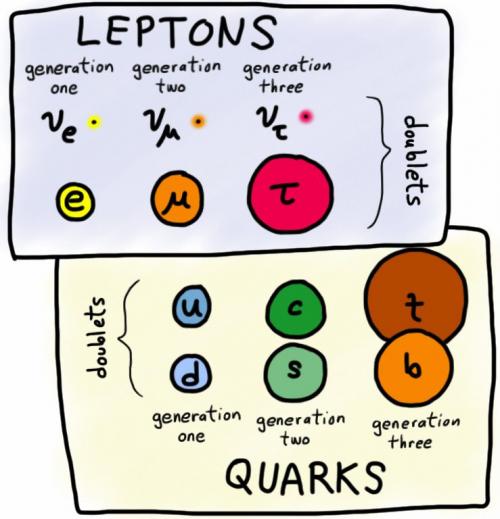In the realm of particle physics, the fundamental building blocks of matter evoke awe and intrigue. Among these elementary constituents, quarks and leptons serve as two distinct families of particles that form the architecture of the universe. This article endeavors to elucidate the distinctions, similarities, and deeper implications of quarks and leptons, which lie at the heart of our understanding of particle physics.
To begin, it is crucial to delineate the definitions of quarks and leptons. Quarks are elementary particles that possess various properties, including color charge, which is pivotal in the strong nuclear interaction—the force that binds protons and neutrons in atomic nuclei. Leptons, on the other hand, are a separate category of particles that do not experience strong interactions, yet they are pivotal in processes such as beta decay and are involved in mediating the weak force.
Quarks and leptons are categorized as fermions, which means they obey the Pauli exclusion principle and have half-integer spin values. The standard model of particle physics provides a comprehensive framework that classifies both quarks and leptons into generations, each containing particles that share similar properties but differ in mass. There are three generations of quarks: up and down, charm and strange, and top and bottom. Similarly, the lepton family comprises the electron, muon, and tau, alongside their corresponding neutrinos.
A noteworthy distinction between these two particle categories lies in their interaction with fundamental forces. Quarks are bound by the strong force and combine to form composite particles known as hadrons—these include baryons (like protons and neutrons) and mesons. This binding process results in the confinement of quarks; they are never found in isolation under normal circumstances. In stark contrast, leptons exist freely and independently, such as electrons in atomic shells or neutrinos passing through ordinary matter with little interaction. This fundamental difference offers a fascinating glimpse into the fabric of the universe, where the observable phenomena emerge from the interplay of these subatomic particles.
Both quarks and leptons are subject to the laws of quantum mechanics, exhibiting wave-particle duality as well as intrinsic properties such as charge and mass. The electric charge of leptons, such as the electron, provides them with the ability to interact electromagnetically, while quarks carry fractional charges, confined within the hadrons they form. In accordance with the standard model, the interactions of quarks and leptons are mediated by gauge bosons—force-carrying particles. For example, the photon mediates electromagnetic interactions, while gluons are responsible for the strong force interactions among quarks.
The unique characteristics of quarks and leptons extend beyond their interactions; they also lead to intriguing questions regarding the symmetry and unification of forces. The pursuit of a Grand Unified Theory (GUT) aims to seamlessly integrate the electromagnetic, weak, and strong forces into a single framework. This endeavor hints at a profound connectivity underlying the universe’s architecture and propels physicists to explore the limits of current theories. The mysterious nature of mass—addressed by the Higgs mechanism—reinforces these explorations, challenging our understanding of how particles acquire their properties.
Moreover, the observable universe is predominantly shaped by baryons, the composite particles formed by quarks, exemplifying the importance of these fundamental interactions. However, the lepton family is equally significant in processes such as solar fusion, where neutrinos produced in the core of the Sun escape into space, providing critical insights into stellar events and the conditions necessary for life on Earth.
To grasp the enigma of quarks and leptons is to delve into the essence of existence itself. The intersection of particle physics and cosmology leads to questions regarding the identity of dark matter and the role of leptons in astrophysical phenomena. For instance, an examination of cosmic rays—a high-energy particle phenomenon—often reveals the transient nature of these particles and provides evidence supporting the validity of the standard model.
The study of quarks and leptons extends into the frontiers of modern physics, encompassing advancements in experimental approaches and computational techniques. Large particle colliders, such as the Large Hadron Collider (LHC), delve into the subatomic realm, providing insights that challenge conventional wisdom and reveal new phenomena. As new particles are discovered, the need for a more robust theoretical framework emerges, suggesting that our current model may be a stepping stone to understanding an even deeper structure within the cosmos.
In conclusion, the fascination with quarks and leptons lies not merely in their empirical properties but also in the broader implications they hold for our understanding of the universe. The complexities of their interactions, their role in the formation of matter, and the ongoing quest for a unified theory of forces highlight the depth of inquiry that characterizes modern physics. As we continue to unravel the mysteries of the subatomic world, the distinctions and connections between quarks and leptons will undoubtedly illuminate our comprehension of the universe in extraordinary ways, triggering profound philosophical reflections on the nature of reality and existence.












